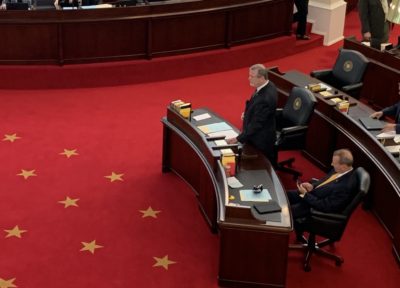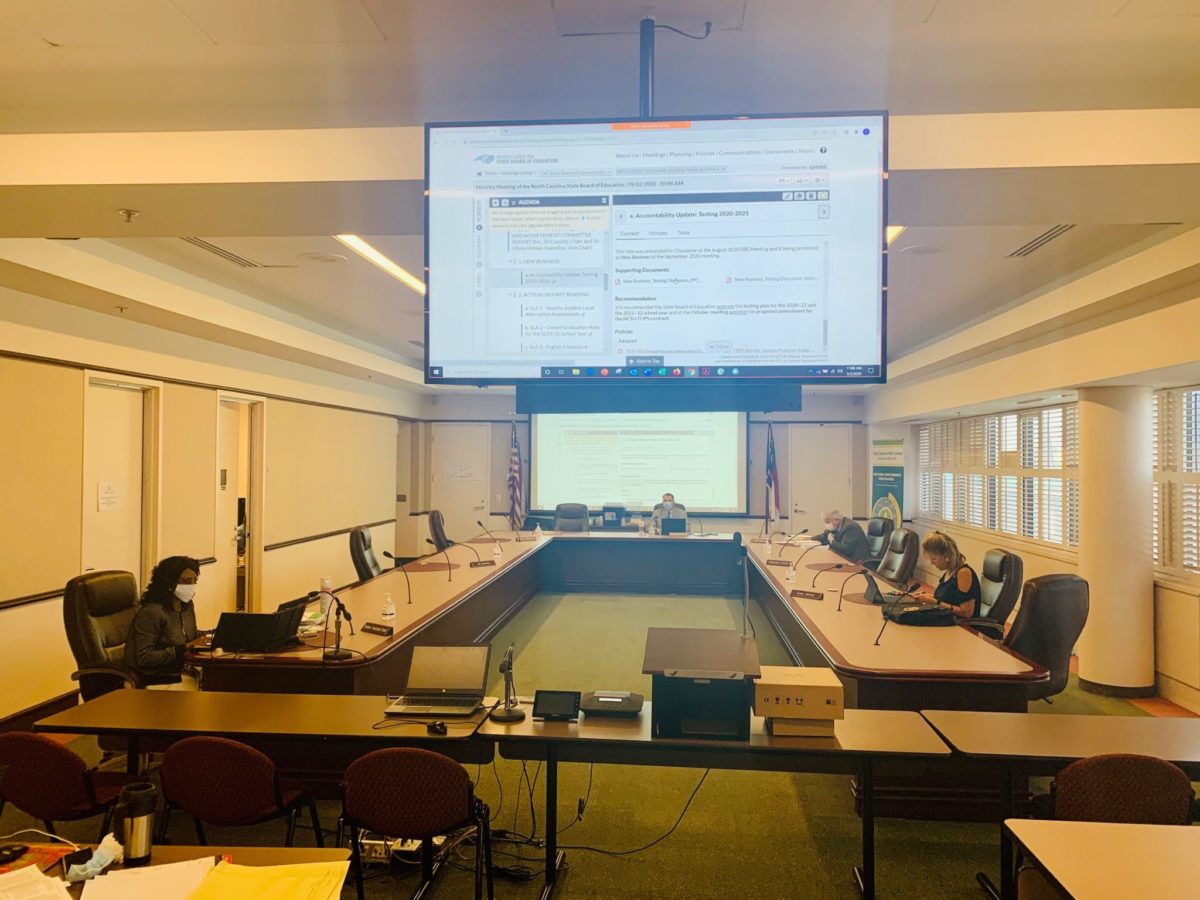

During a two-day meeting this week, the State Board of Education approved a new equity resolution and heard about the state’s graduation rate, the status of districts’ remote instruction plans, K-3 reading diagnostic tools, and more. They also got an update on how the school year is going so far. Here is a recap.
Equity resolution focus of debate
Some State Board members questioned the creation of an equity officer and other language included in an equity resolution approved by the Board this week.
The resolution, called “A Resolution To Support Equity And Excellence In North Carolina Public Education,” includes the following language:
“RESOLVED, that the State Board will review and appropriately revise its policies through an equity lens and commit to work with the Superintendent and the Department of Public Instruction to create and maintain an equity officer to ensure consistency and continuity with this essential guiding principle inside and outside the agency;…”
Republican-appointed Board Member Olivia Oxendine said that is a big deal.
“When we resolve to do that, that means that’s a huge promise we’re making to ourselves and others,” Oxendine said.
She said she was concerned by the lack of specifics, such as what the powers of such an officer would be and to whom the person would report.
Oxendine also asked whether there were any American Indian representatives on the team that came up with the equity resolution and whether rural areas of the state were represented.
State Board Member James Ford, co-chair of the State Board committee that presented the resolution and a Democratic appointee to the Board, said the equity resolution was just stating an intention rather than getting into the details of what an equity officer would be.
“What this is more doing is a commitment to a leader overseeing that work,” he said. “But certainly I think as we get into the implementation of this, discussions about who and what that looks like are important.”
Ford said that he wasn’t sure if an American Indian voice was involved in the creation of the resolution, though he said the group that worked on it was multiracial and had a good mix of urban and rural representatives.
Board Member Amy White, also a Republican appointee, worried about the inclusion of the term “gender” in the resolution, preferring to use the terms “boys” and “girls.”
The line in the resolution states:
“WHEREAS, gender is a determinant of equity, and we have an imperative duty to construct educational systems to eradicate gender biases to support students of all genders;…”
White said she has a Biblical worldview and believes that God created men and women.
“I wish we were using different wording to better articulate the fact that we need more equitable practices for boys and for girls,” she said, adding: “That word ‘gender’ opens a Pandora’s Box for me.”
Other Board members, like Democratic appointee Reginald Kenan, praised the resolution.
“The equity issue is a very relevant issue now more than ever,” he said, adding later: “(The resolution) is another form of action. Talk is good, but action is better.”
State Board Chair Eric Davis ended the discussion by praising Board members for their ability to discuss important issues like this.
“While some may believe that civil discourse doesn’t exist, it sure does exist for this group, and I’m grateful that we can have these difficult discussions,” he said. “I’m grateful that we can disagree and still find a path forward to serve the students of North Carolina.”
Davis is a Republican appointee to the Board — registered as unaffiliated — but on issues where votes break on party lines, he often sides with Democratic appointees.
White and Oxendine both voted against the resolution, as did Todd Chasteen, also a Republican appointee to the Board. They were the only ones to do so.
COVID-19’s impact on schools
Susan Gale Perry, chief deputy secretary of the State Department of Health and Human Services (DHHS), told the State Board of Education that the state’s schools aren’t seeing large numbers of COVID-19 cases since some schools reopening for in-person instruction on Aug. 17.
As of September 1, there have been six confirmed clusters in K-12 schools, four of which were reported after Aug. 17.
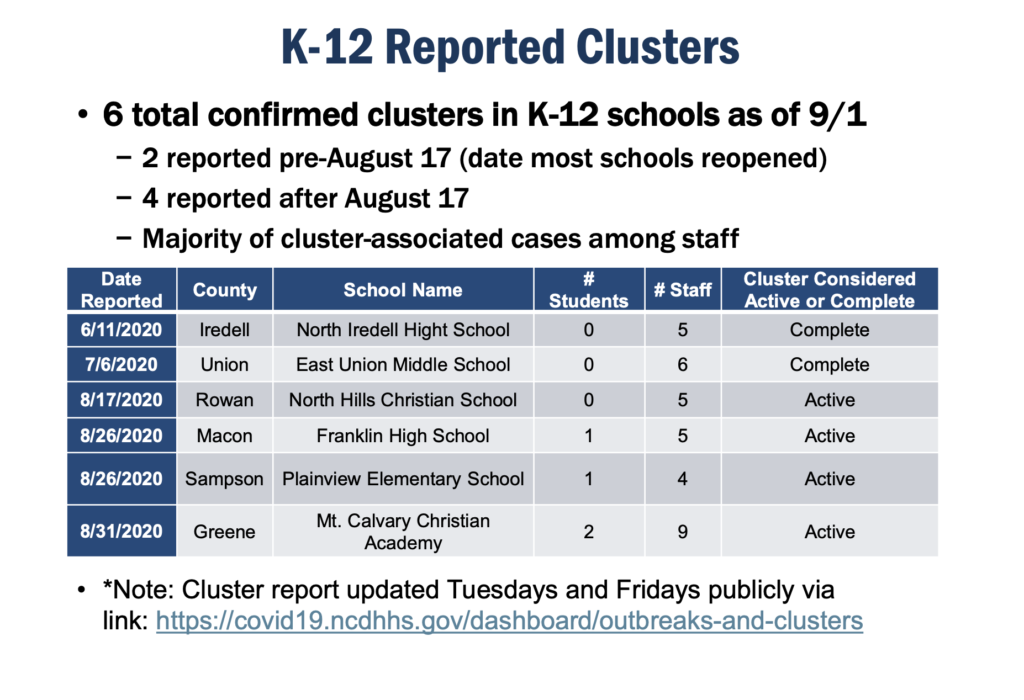

Here are highlights from a survey to school districts and charter schools sent out by DHHS.
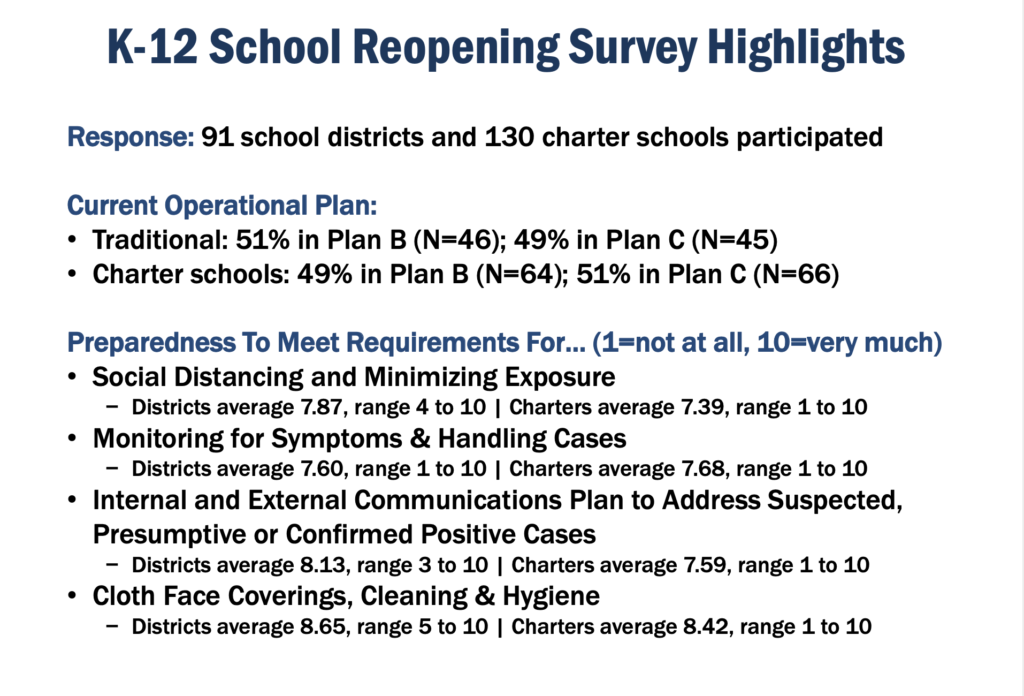

The presentation also covered child care. According to DHHS data, about 64 school districts with a total of 987,000 students started the school year fully remote and may need child care services five days a week. Even students in plan B, which includes a mix of in-person instruction and remote instruction, will need at least some child care. The presentation included resources available to those who need child care.
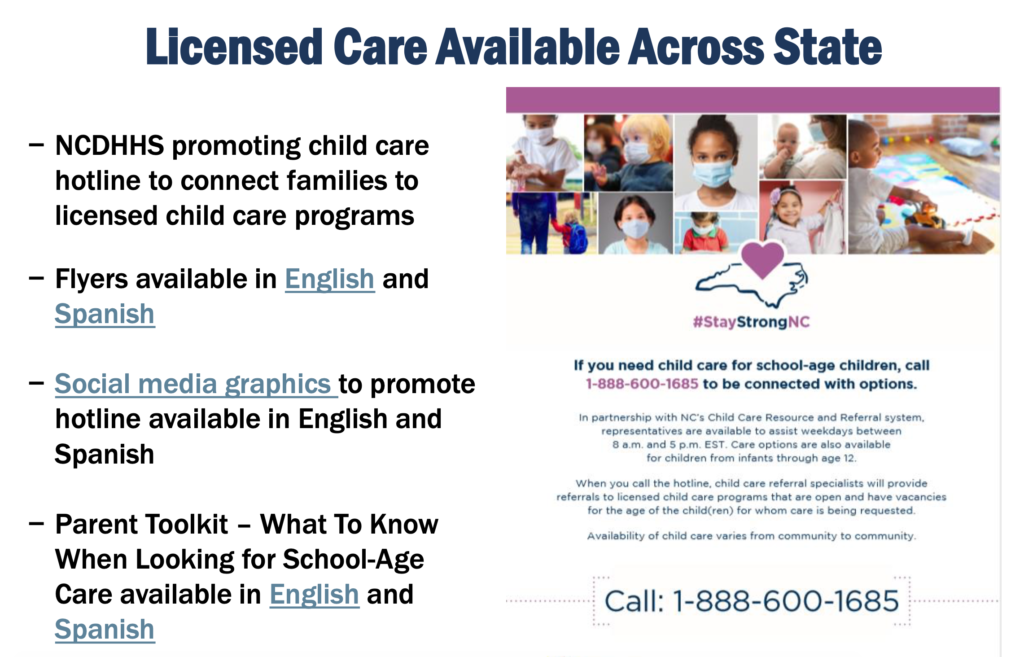

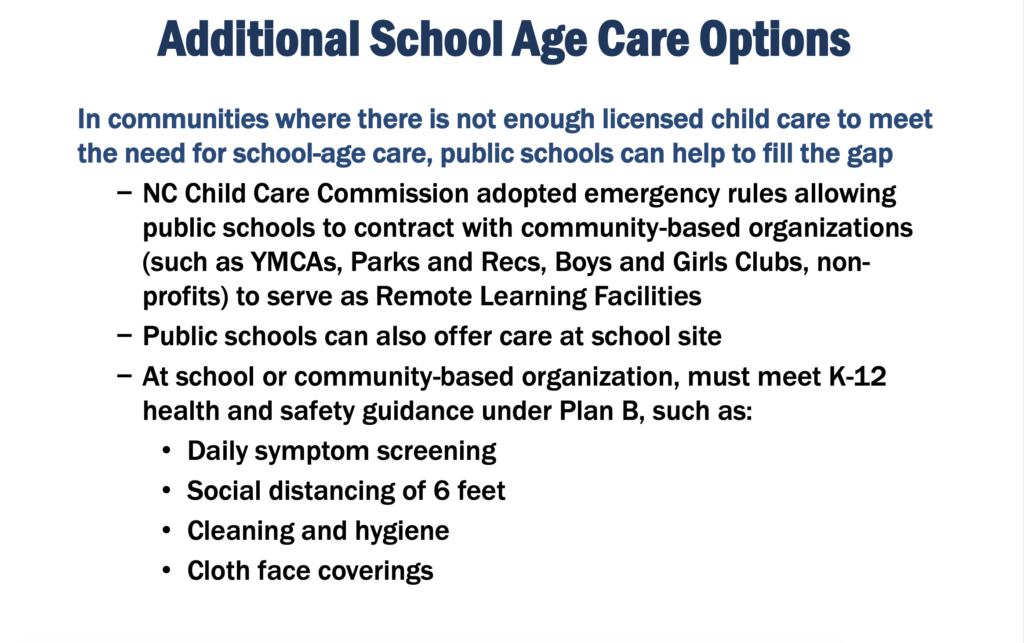

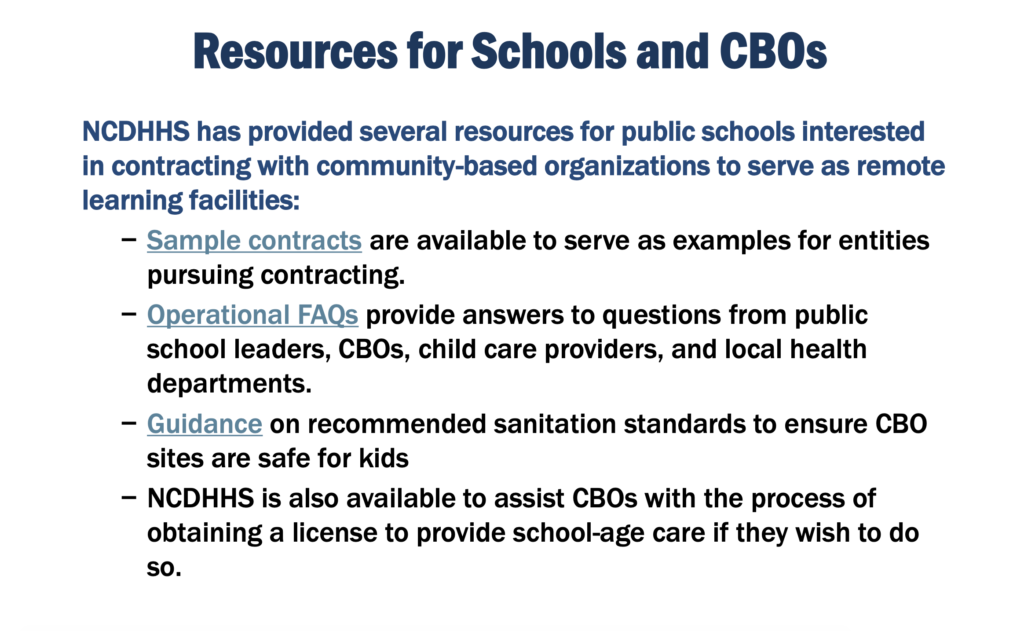

Governor’s CARES Act funding
As part of the federal CARES Act, Gov. Roy Cooper got $95.6 million that he could allocate to the state’s public schools and postsecondary education system to help mitigate the impacts of COVID-19. This is just one portion of COVID-19 relief funds the state’s public school system has received. The General Assembly also had funds that they were able to work with, and the state’s school districts received other COVID-19 relief funds directly from the federal government.
Cooper decided to use $60 million of the funds at his discretion for the state’s public school system, with $40 million going to hire “school nurses, counselors, social workers, and psychologists,” according to a presentation at the State Board of Education this week. The other $20 million is going to “support the academic needs of at-risk students and students with disabilities.”
The Board also heard how the money would be allotted around the state.
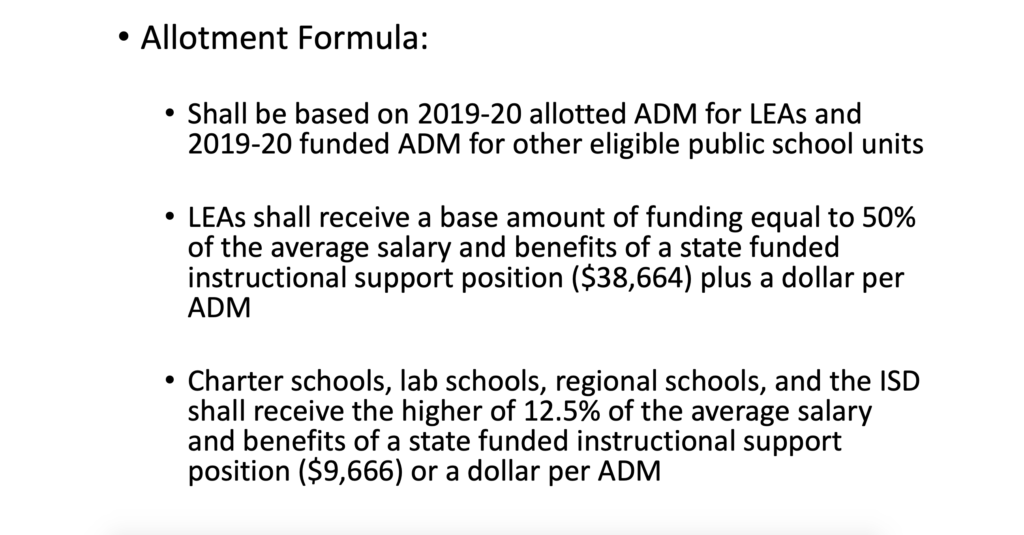

And Board members saw a document with the proposed financial distributions to districts and schools around the state.
First, here is the proposal to distribute the $40 million for school support personnel.
And here is the proposed distribution of the remaining $20 million.
The State Board voted to accept the proposal from the governor.
Transportation flexibility
The State Board of Education also voted to give flexibility to school districts in how they use their transportation funds.
The decision arose because the transportation allotment (PRC 056) is supposed to be used by districts for transporting students “to, from, and between schools for their instructional program.” But for items such as delivering instructional materials, taking students to “small group instruction,” and delivering meals to students during remote learning, the money can’t be used.
Obviously, with many students in the state doing remote learning only, and the rest doing a combination of in-person and remote learning, districts are using their school buses differently. Without access to the needed funds, problems are arising, according to a survey discussed in a presentation to the State Board.
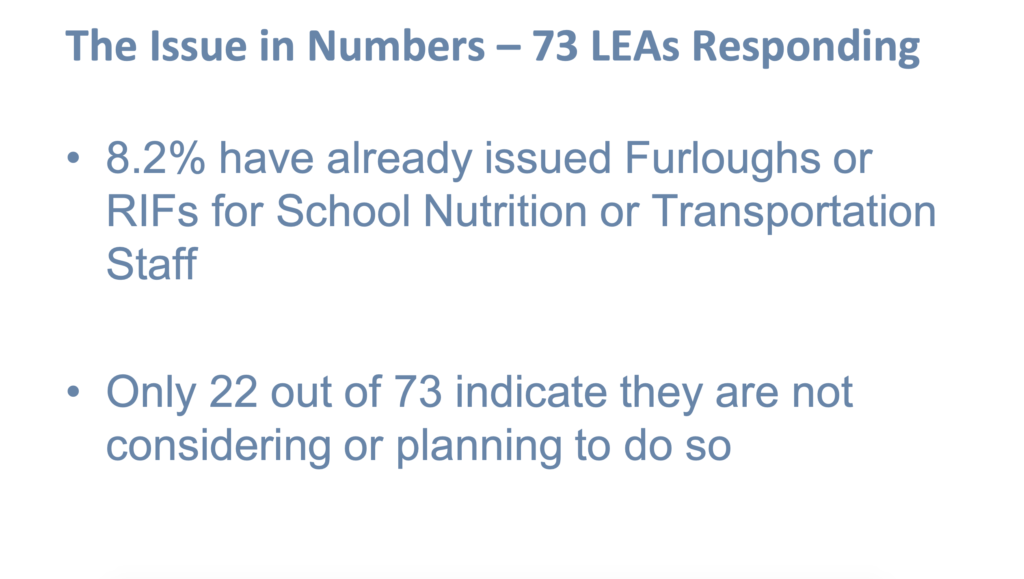

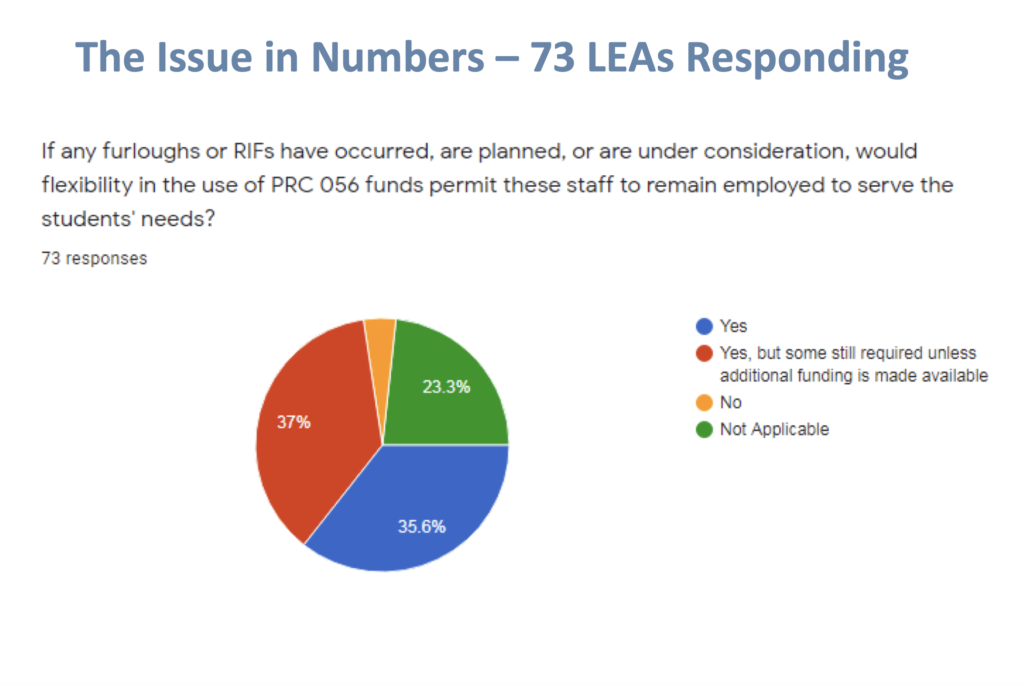

The Board voted to grant flexibility in the use of the transportation funds so that districts can use the money how they need.
The Board voted more specifically to allow the allotments to be used “for purposes which support students’ nutrition or instruction” during a “declared state of emergency.”
Here is the full presentation:
K-3 reading diagnostic
In contrast to previous years, school districts this year were allowed to choose their own K-3 reading diagnostic tool from a list approved by the state.
According to state Superintendent of Public Instruction Mark Johnson, most districts are choosing Istation while only 8% picked mClass.
“The tool serving most K-3 students in district schools this year will be Istation, serving 160,000 students. Istation is followed closely by iReady. iReady will serve just over 140,000 students. The next highest total is for the MAP assessment tool, which is at about 60,000 students. Together, the computer adaptive technologies of Istation, iReady, MAP, and STAR will serve over 90% of all K-3 students. Districts also have the option to select mClass, the tool used statewide until 2018. 8% of students will use mClass in the 2020-21 school year,” stated a press release from the state Department of Public Instruction (DPI).


This all came about after a long period of strife over what diagnostic tool the state should be using.
As part of the Read to Achieve program, a diagnostic tool is required to measure the progress of students.
DPI originally chose Istation to be the state’s tool, replacing mCLASS, a product of the company Amplify, that had been in use in the state’s public schools for years.
The procurement process for that contract became a source of a lot of contention. Amplify — a competitor in the bidding process — took issue with how the procurement process happened. The state Department of Information Technology (DIT) had been reviewing how Istation was chosen and put a stay on the implementation of that contract while the issue was being litigated.
In April of this year, DPI canceled its three-year contract with Istation and Johnson said a new procurement process would start.
In May, Johnson announced that districts would be able to pick their own diagnostic this fall.
In June, DIT canceled the case surrounding the procurement process.
Graduation rate
The four-year graduation rate for 2020 in North Carolina was 87.6%, up 1.1% from the year before.
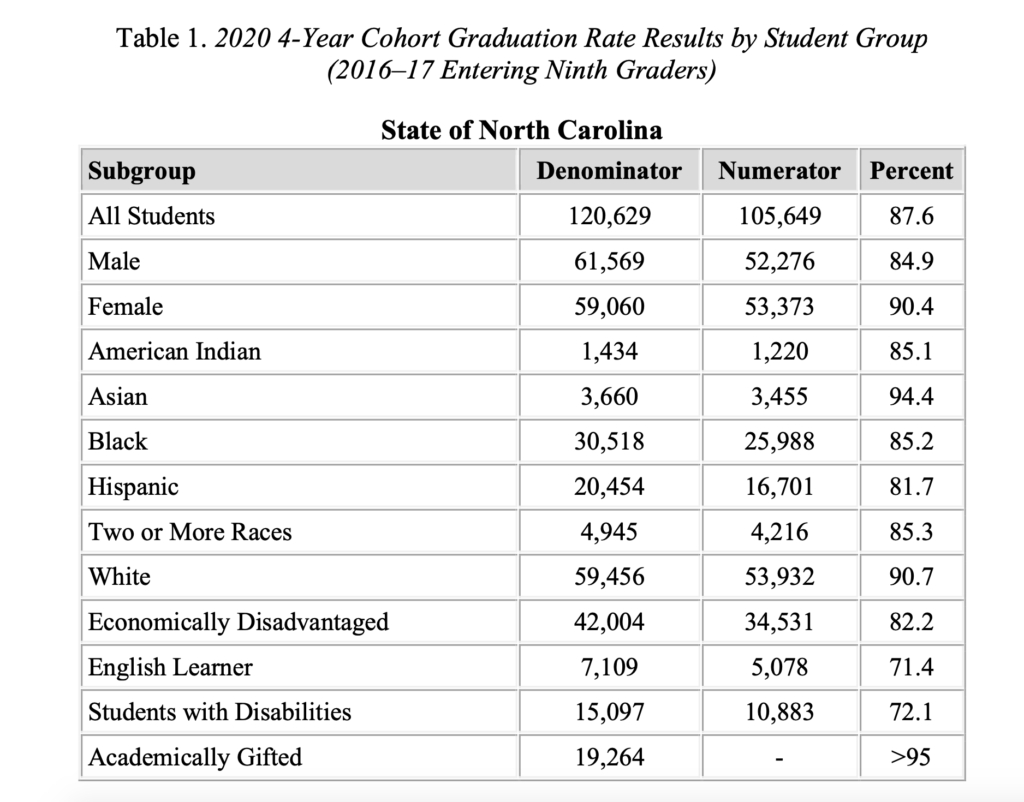

Comparing the chart above with the chart below, you can see that the graduation rate for certain subgroups also went up from 2019. The graduation rate for Black students went from 83.7% in 2019 to 85.2%, American Indian from 81.2% to 85.1%, and Hispanic from 81.1% to 81.7%. Economically disadvantaged students went from 81.8% to 82.2%.
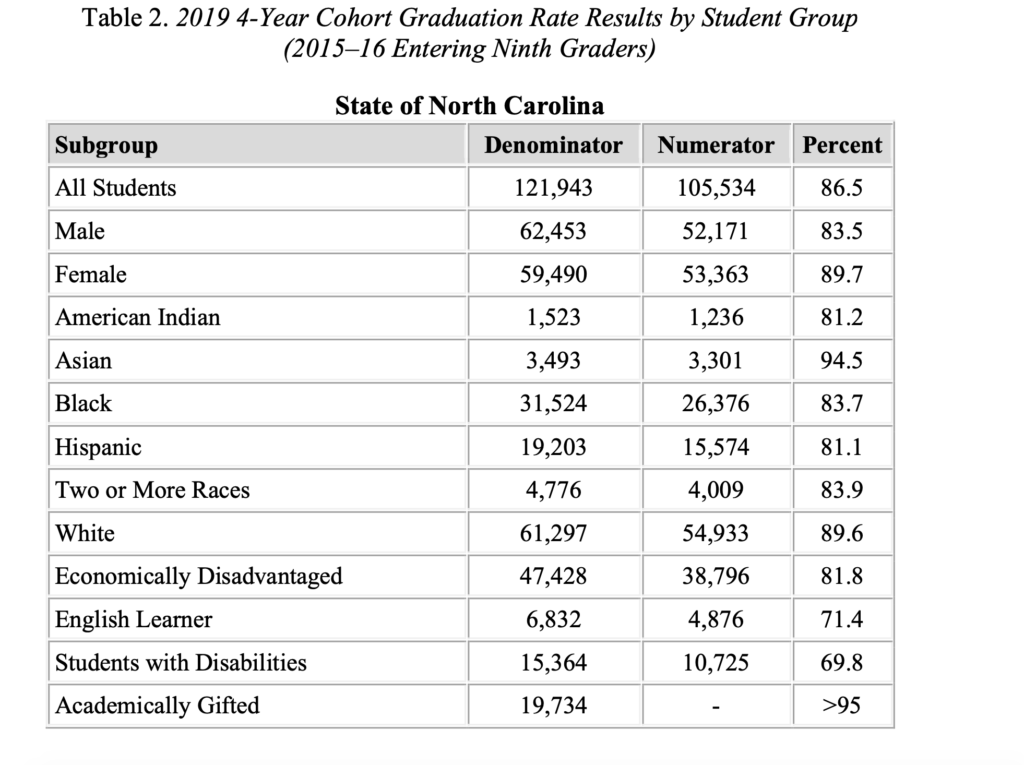

Ordinarily, the State Board of Education would be hearing more accountability data this month, but due to COVID-19 and the closing of schools for in-person instruction in the spring, many of those accountability measures were suspended for last year.
The Board did, however, hear some Read to Achieve data, at least as it stood at March 13, 2020 when in-person instruction ended.
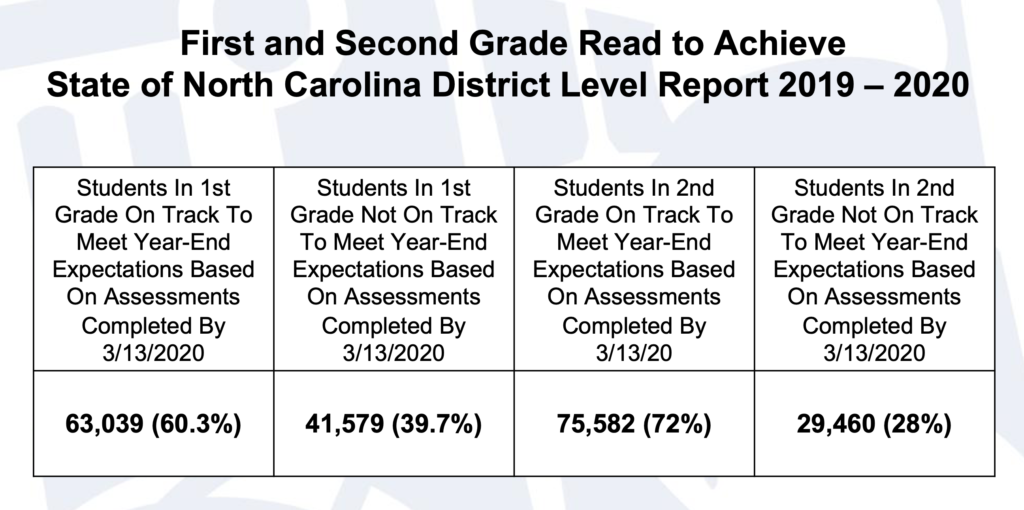

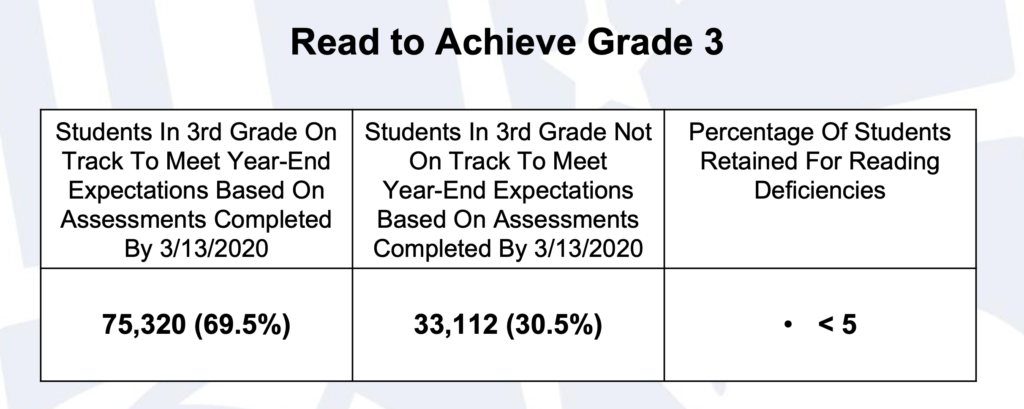

Remote education plans
In the lead up to the 2020-21 school year, districts and charter schools around the state were required to submit remote instruction plans to DPI. DPI had to then report on those plans to the General Assembly.
The State Board approved that report at its meeting this week.
Included in the report are the challenges districts say they face when it comes to remote instruction. They include internet access, professional development, funding, lack of devices, and supporting families.
Also included are quotes on the challenges from a survey sent out to “public school units.”
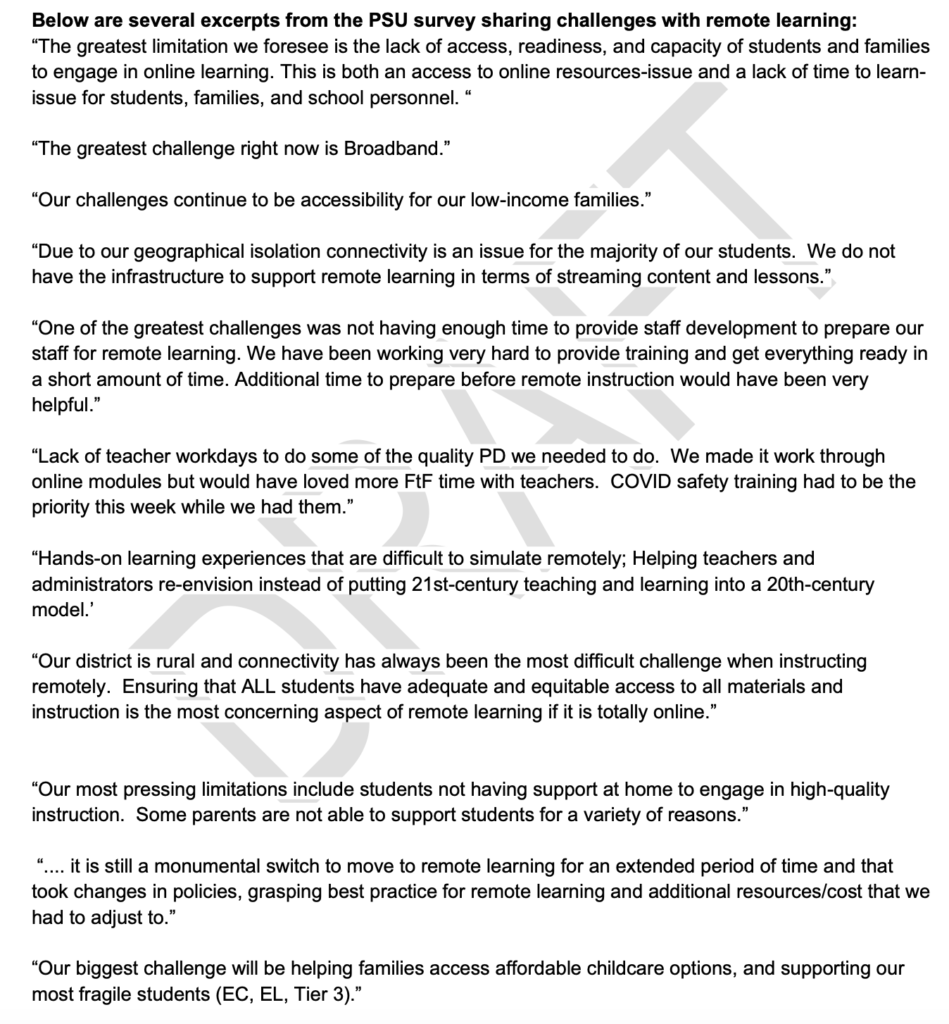

Teacher observations
The State Board of Education voted to approve a plan on how teacher evaluations will happen this year given the fact that at least some of them will have to take place without instruction happening in the classroom.
Formal teacher observations were suspended in the spring when all learning went online. Now, under this plan, evaluations would be permitted during both in-person and virtual instruction.
The following presentation gives an overview of the evaluation plan.
Virtual End-of-Grade tests?
During a presentation to the State Board of Education, Tammy Howard, director of accountability services at DPI, said DPI is exploring the possibility of administering End-of-Grade and End-of-Course tests at home in the spring.
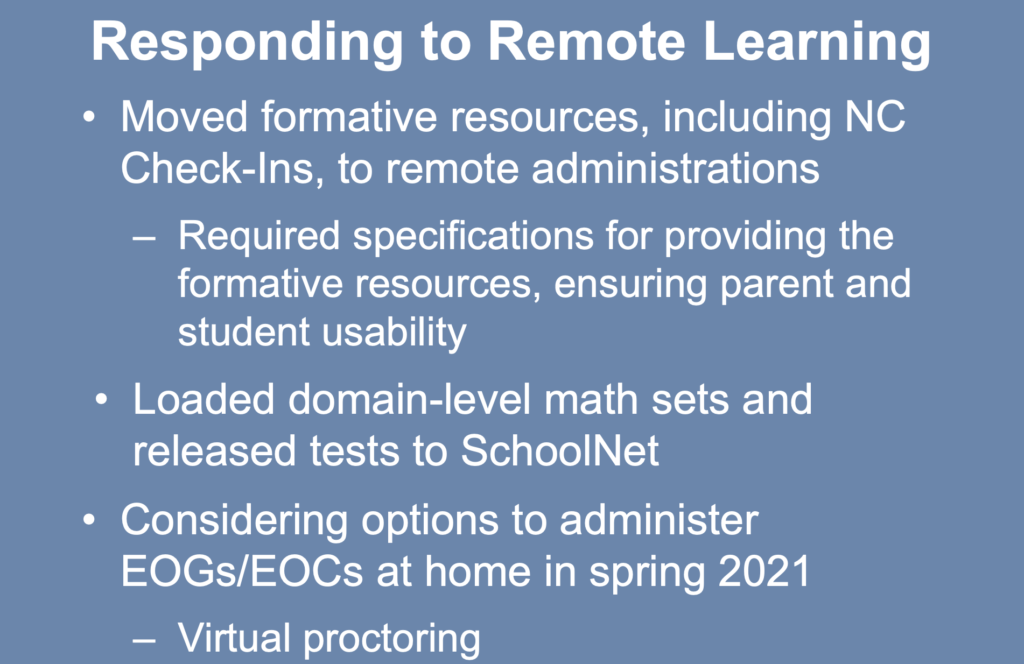

Required testing was suspended last spring because of COVID-19, which required waivers from the state and federal government. So far this year, those waivers are not forthcoming, and the plan is for required testing to go ahead.
Here is the full accountability update presentation.
Accountability model for educator preparation programs
The State Board recommended a new accountability model for educator preparation programs (EPPs) to be presented to lawmakers for approval.
The model would evaluate the state’s EPPs based on performance, retention rate, stakeholder perceptions, and diversity.
Here is how that would break down.
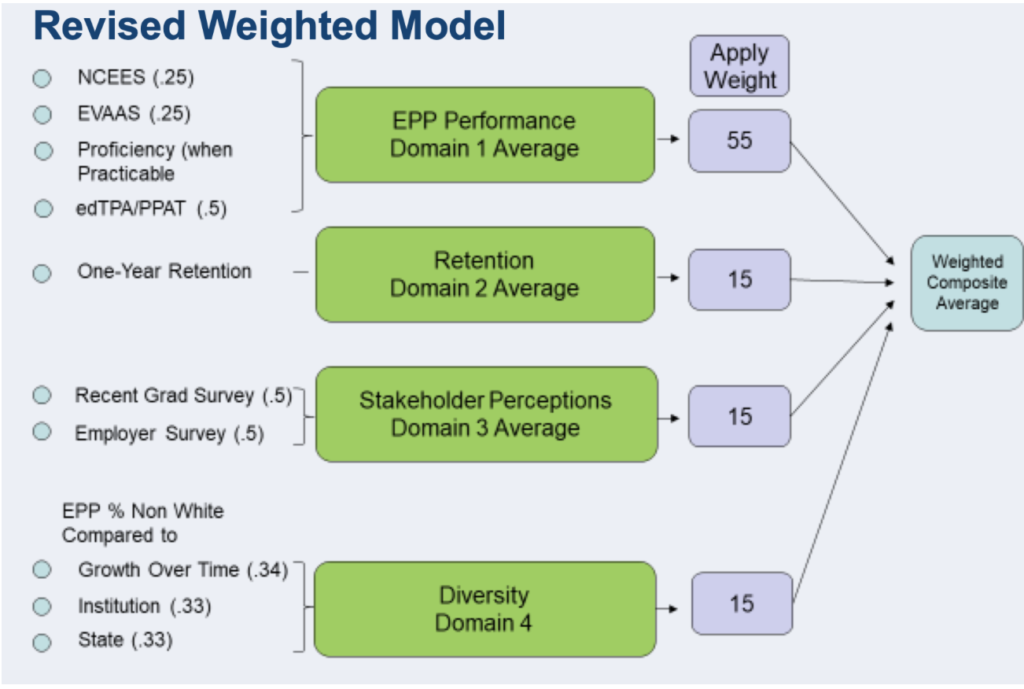

Read more about the model, and how and why it came about here and by following the links in the article.
State Board leadership
Every September, the State Board of Education has to choose a new chair and vice chair of the Board. Eric Davis was reelected by the Board to be chair, and Alan Duncan was reelected to be vice chair. The votes were unanimous.


